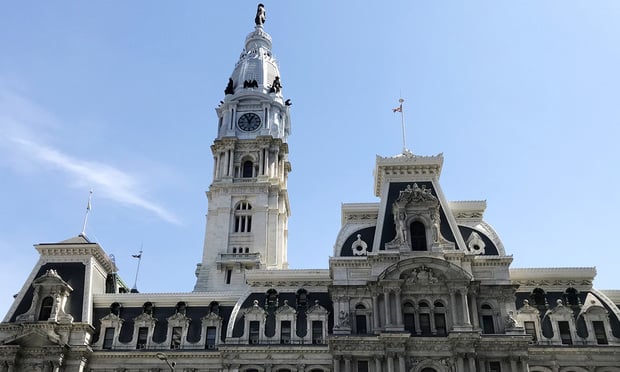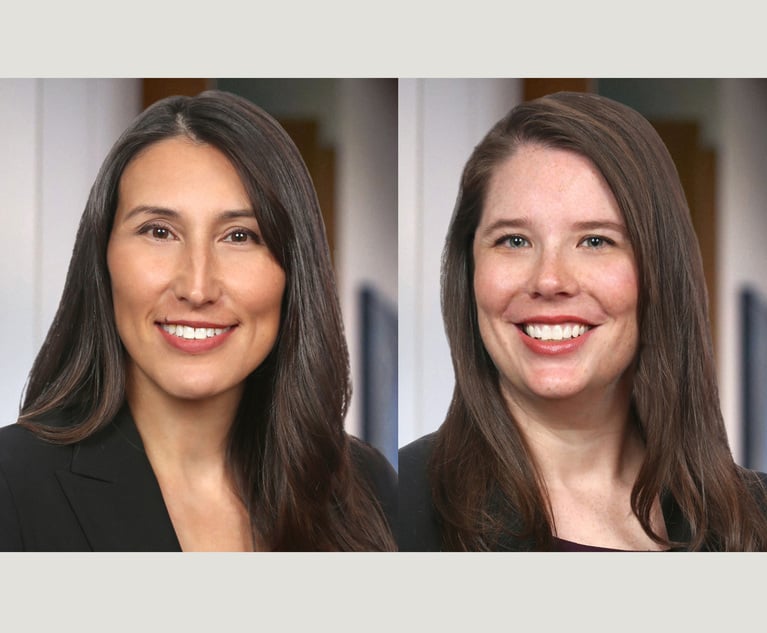Blood Filter Cases on Upswing in Phila. as Risperdal Continues to Dominate Mass Tort Docket
All of that growth occurred as a function of pharmaceutical litigation, with the asbestos inventory slowly declining to 562 in 2019—the lowest level since 2010.
February 14, 2020 at 03:29 PM
4 minute read
 Philadelphia City Hall building. Photo: Diego M. Radzinschi/ALM
Philadelphia City Hall building. Photo: Diego M. Radzinschi/ALM
Philadelphia's Complex Litigation Center remains crowded with Risperdal cases, but it was litigation over removable blood filters that became the fastest-growing mass tort program at the First Judicial District in 2019.
According to the latest numbers on the court's mass torts inventory, the number of lawsuits over the IVC, or inferior vena cava, filters nearly doubled since January 2019, but nearly all other mass tort programs in Philadelphia saw minimal or negative growth. Still, because of the lingering effects of a flood of lawsuits into the Risperdal litigation in 2017, the total number of cases pending in the court's Complex Litigation Center remains almost as high as it's ever been.
Court statistics measuring the mass tort programs through Jan. 5 said the total number of cases pending on the dockets is 10,719. That number is a 10% increase from the start of 2019, and just 265 cases shy of the record peak the court saw in 2018, when it had 10,984 cases pending in the mass tort programs.
All of that growth occurred as a function of pharmaceutical litigation, with the asbestos inventory slowly declining to 562 in 2019—the lowest level since 2010. The numbers said that, at nearly 8% of the total inventory, IVC filter litigation is the third largest mass tort program.
According to the stats, the IVC filter litigation saw 92% growth over the past 12 months, rising from 438 to 842 as of early January. The litigation saw its first Philadelphia case come to trial in October. The case, Reed-Brown v. Rex Medical, resulted in a $33 million verdict, with the jury awarding more than $30 million in punitive damages.
IVC filter litigation focuses on allegations that the defendants failed to properly warn about the dangers of the filter devices, which were designed to prevent blood clots, but can allegedly migrate or fracture in patients' bodies, causing perforations. The injuries, according to plaintiffs, put patients at risk for a host of medical problems, including gastrointestinal difficulties, kidney failure and death.
Two more cases over IVC filters are set to go to trial in the last summer and fall.
The only other mass tort program to see any growth during 2019 was Risperdal, which takes up nearly 65% of the total mass tort inventory. According to the numbers, the litigation saw 926 new cases filed, but with 596 disposed, it only increased by 369, which is 6% of the 6,912 cases that were pending as of January.
Litigation over the blockbuster antipsychotic drug Risperdal has been the dominant mass tort since 2017, when the number of cases jumped from 1,945 to 6,200 by late December of that year—a 219% increase over the 12-month period. According to attorneys handling the litigation, the explosive growth the court saw over 2017 was due mostly to the parties scrapping a tolling agreement, which led thousands of plaintiffs to file suit in order to preserve their claims.
The program could see some additional grow as well, after the Pennsylvania Supreme Court in November overruled a lower court decision that set a strict deadline for bringing Risperdal claims at two years after June 2009. Instead, the justices said the start date of the statute of limitations must be determined by a jury following a factual analysis in each individual case.
A case out of the Risperdal program also ended with a jury handing up an $8 billion award against the Johnson & Johnson subsidiary, Janssen Pharmaceuticals. The award was later reduced to $6.8 million, but by then it had already grabbed the attention of attorneys across the country.
According to the court statistics, the Essure litigation has grown to 288 since it was consolidated in the spring, and now constitutes nearly 2.7% of the total inventory. The pelvic mesh litigation saw an increase of 40 filings over the 88 cases that were pending at the start of 2019, but with 65 cases being disposed, and 18 being reopened, the program ended the year with 81 pending cases, which is an 8% drop over last year's total.
The percentage of plaintiffs filing from outside Pennsylvania fell slightly from last year as well. According to the numbers, 85% of the pharmaceutical cases filed in the FJD over the past year were from out-of-state litigants, down just 1% from the 86% the court saw in 2018. The number of out-of-state plaintiffs filing in Philadelphia peaked in 2017, at 90%, but the year before that, the court saw a record low of out-of-state plaintiffs, with 74%.
This content has been archived. It is available through our partners, LexisNexis® and Bloomberg Law.
To view this content, please continue to their sites.
Not a Lexis Subscriber?
Subscribe Now
Not a Bloomberg Law Subscriber?
Subscribe Now
NOT FOR REPRINT
© 2025 ALM Global, LLC, All Rights Reserved. Request academic re-use from www.copyright.com. All other uses, submit a request to [email protected]. For more information visit Asset & Logo Licensing.
You Might Like
View All

Trending Stories
- 1German Court Orders X to Release Data Amid Election Interference Concerns
- 2Litigation Trends to Watch From Law.com Radar: Suits Strike at DEI Policies, 'Meme Coins' and Infractions in Cannabis Labeling
- 3Judge Gets Public Reprimand for Favoring Cops
- 4Investor Sues in New York to Block $175M Bitcoin Merger
- 5Landlord Must Pay Prevailing Tenants' $21K Attorney Fees in Commercial Lease Dispute, Appellate Court Rules
Who Got The Work
J. Brugh Lower of Gibbons has entered an appearance for industrial equipment supplier Devco Corporation in a pending trademark infringement lawsuit. The suit, accusing the defendant of selling knock-off Graco products, was filed Dec. 18 in New Jersey District Court by Rivkin Radler on behalf of Graco Inc. and Graco Minnesota. The case, assigned to U.S. District Judge Zahid N. Quraishi, is 3:24-cv-11294, Graco Inc. et al v. Devco Corporation.
Who Got The Work
Rebecca Maller-Stein and Kent A. Yalowitz of Arnold & Porter Kaye Scholer have entered their appearances for Hanaco Venture Capital and its executives, Lior Prosor and David Frankel, in a pending securities lawsuit. The action, filed on Dec. 24 in New York Southern District Court by Zell, Aron & Co. on behalf of Goldeneye Advisors, accuses the defendants of negligently and fraudulently managing the plaintiff's $1 million investment. The case, assigned to U.S. District Judge Vernon S. Broderick, is 1:24-cv-09918, Goldeneye Advisors, LLC v. Hanaco Venture Capital, Ltd. et al.
Who Got The Work
Attorneys from A&O Shearman has stepped in as defense counsel for Toronto-Dominion Bank and other defendants in a pending securities class action. The suit, filed Dec. 11 in New York Southern District Court by Bleichmar Fonti & Auld, accuses the defendants of concealing the bank's 'pervasive' deficiencies in regards to its compliance with the Bank Secrecy Act and the quality of its anti-money laundering controls. The case, assigned to U.S. District Judge Arun Subramanian, is 1:24-cv-09445, Gonzalez v. The Toronto-Dominion Bank et al.
Who Got The Work
Crown Castle International, a Pennsylvania company providing shared communications infrastructure, has turned to Luke D. Wolf of Gordon Rees Scully Mansukhani to fend off a pending breach-of-contract lawsuit. The court action, filed Nov. 25 in Michigan Eastern District Court by Hooper Hathaway PC on behalf of The Town Residences LLC, accuses Crown Castle of failing to transfer approximately $30,000 in utility payments from T-Mobile in breach of a roof-top lease and assignment agreement. The case, assigned to U.S. District Judge Susan K. Declercq, is 2:24-cv-13131, The Town Residences LLC v. T-Mobile US, Inc. et al.
Who Got The Work
Wilfred P. Coronato and Daniel M. Schwartz of McCarter & English have stepped in as defense counsel to Electrolux Home Products Inc. in a pending product liability lawsuit. The court action, filed Nov. 26 in New York Eastern District Court by Poulos Lopiccolo PC and Nagel Rice LLP on behalf of David Stern, alleges that the defendant's refrigerators’ drawers and shelving repeatedly break and fall apart within months after purchase. The case, assigned to U.S. District Judge Joan M. Azrack, is 2:24-cv-08204, Stern v. Electrolux Home Products, Inc.
Featured Firms
Law Offices of Gary Martin Hays & Associates, P.C.
(470) 294-1674
Law Offices of Mark E. Salomone
(857) 444-6468
Smith & Hassler
(713) 739-1250







